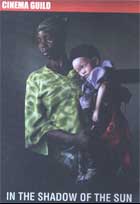
In the Shadow of the Sun 2013
Distributed by Cinema Guild, 115 West 30th Street, Suite 800, New York, NY 10001; 212-685-6242
Produced by Harry Freeland
Directed by Harry Freeland
DVD, color, 85 min.
College - General Adult
Sociology, Africa, Albinism, Genetics, Human Rights
Date Entered: 02/21/2014
Reviewed by Rodney Birch, Reference Librarian, George Fox UniversityThrough this film, Freeland explores a topic not often considered or discussed: albinism, specifically in relation to the African nation of Tanzania. The film is a narrative approach, following the personal struggles and advocacy work of a group of Tanzanian albinos. Albinism is a genetic condition in which a person’s skin is void of melanin, resulting in little to no pigment. For black Africans, this makes their skin white or near white in appearance. Additionally, albinos deal with impaired eyesight as a result of albinism. Black persons born with this condition are often labeled as white ghosts or demons as a result of superstitious beliefs perpetuated by the witch doctors. Many of the albinos are isolated and forced to live on an island: children are not able to enroll in school, adults are not able to find employment. Tanzanian albinos face persecution and prejudice, often fearing for their lives, as they are often murdered for their limbs. The witch doctors feed the superstition toward albinos by telling people that producing a limb from an albino will make them rich. However, through the advocacy and education work of the albinos, the Tanzanian government is cracking down on those who would murder the albinos for their limbs. The advocacy work serves to meet with the village and community leaders, as well as members of the community to talk about albinism – appealing to the person’s humanness (albinos are no less human than non-albinos).
Harry Freeland captures the human emotion of persons who are born with albinism struggling to fit in to a society that largely rejects them. Through various advocacy efforts, the albinos are gaining the support and protection of the Tanzanian government as it works to crack down on the atrocities toward the albinos. However, there continues to be a market for albino body parts in certain parts of Tanzania. The video is insightful, but can be graphic at times as images of amputated albino body parts are shown.
This DVD would be a useful resource for ethnographic projects in sociology, ethnic studies, genetics, human rights, and Africa studies.